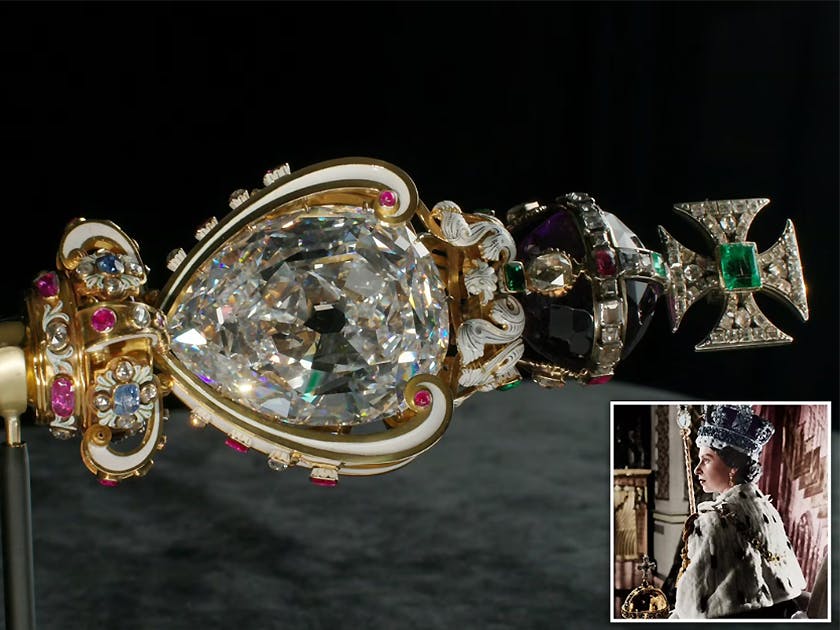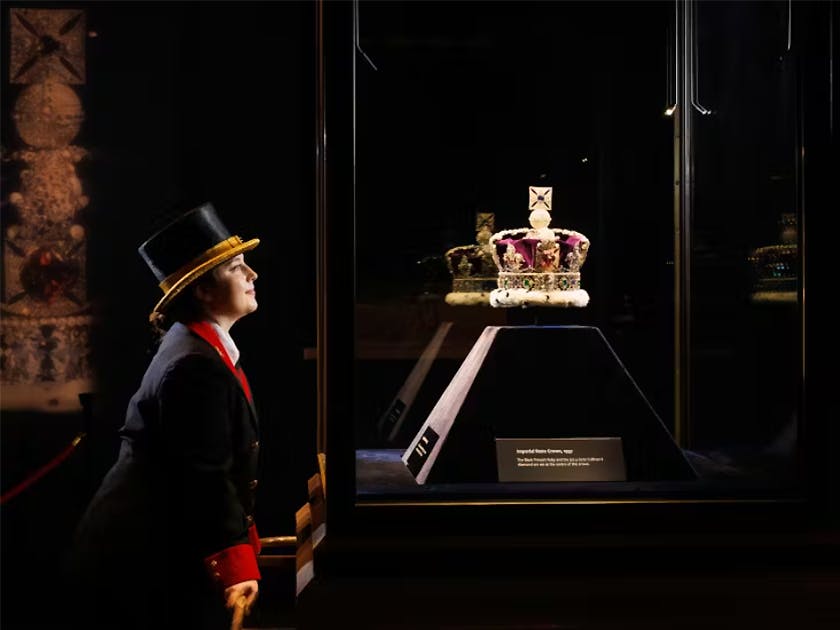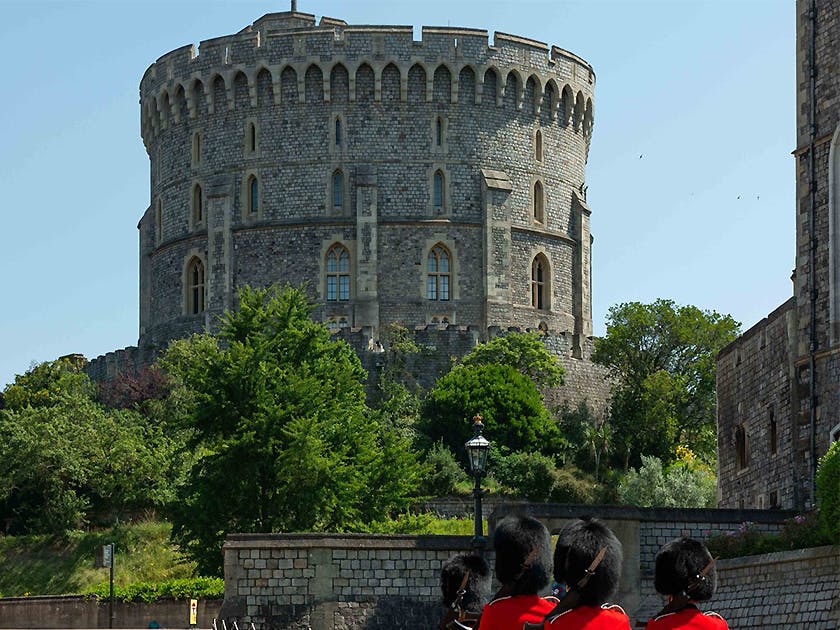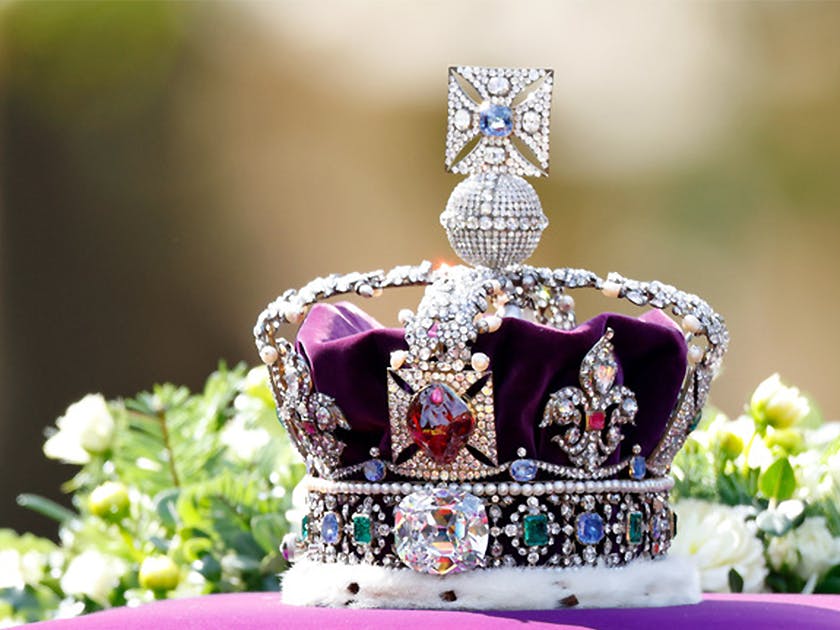
The Crown Jewels are the heart of British royal heritage, comprising crowns, scepters, and other ceremonial items used during key state events like coronations. Housed securely in the Tower of London’s Jewel House, they are significant for their historical value and craftsmanship. This article explores their history, key pieces, and the role they continue to play in modern ceremonies.
- Key Takeaways
- The History of Crown Jewels
- Key Pieces in the Collection
- The Role of Crown Jewels in Coronations
- The Jewel House at the Tower of London
- Famous Monarchs and Their Jewels
- Modern Use and Display
- The Royal Collection Trust
- Notable Diamonds and Precious Stones
- The Impact of Historical Events on Crown Jewels
- Buying, Selling, and Loaning Crown Jewels
- Summary
1 KEY TAKEAWAYS
- The Crown Jewels have a storied history dating back to the medieval era, undergoing destruction and subsequent restoration, with major pieces like the Coronation Spoon surviving from the 12th century.
- Key pieces in the Crown Jewels collection, such as the Sovereign’s Sceptre with Cross and the Imperial State Crown, feature extraordinary diamonds like Cullinan I and Cullinan II, representing significant historical and symbolic value.
- The Crown Jewels are safeguarded at the Jewel House in the Tower of London, where they serve both as ceremonial regalia in modern state events and as historical artifacts on public display, maintained by the Royal Collection Trust.
2 THE HISTORY OF CROWN JEWELS

The Crown by The People
The saga of the Crown Jewels begins in the medieval era, an epoch of monarchs and myths. These luminous symbols of monarchy have withstood the test of time, bearing witness to the rise and fall of dynasties. Yet, their journey has not been without turmoil. The Coronation Spoon, dating back to the 12th century, is the sole medieval survivor of the Crown Jewels’ cataclysmic destruction in 1649. In the wake of regicide and the abolition of the monarchy, the original regalia were nearly lost to oblivion, sold or destroyed under Parliament’s orders.
Rising from the ashes of their predecessors, the Crown Jewels were reborn in 1661, commissioned for the coronation of Charles II as a symbol of restored majesty. Robert Vyner, the Royal Goldsmith, faced the monumental task of crafting regalia that would once again encapsulate the glory of the British Crown. From the splendor of St Edward’s Crown to the solemnity of the coronation regalia, this new collection embodied the renewed spirit of the monarchy.
3 KEY PIECES IN THE COLLECTION
Amidst the Crown Jewels, certain pieces stand out, casting a spell of grandeur with their intricate designs and storied past. The sovereign’s sceptre with cross, originally created for Charles II, is a masterpiece of craftsmanship, its gold rod adorned with enamelled collars and brimming with emeralds and amethysts. This sceptre underwent a transformation in 1910 to house the Cullinan I diamond, a gem of staggering proportions at 530.2 carats, that can be detached and worn separately, signifying the piece’s dual function as both regalia and jewel.
The Imperial State Crown is another crown jewel that captivates onlookers with its resplendence. Set with the Cullinan II diamond, it is a treasure of the British monarchy, representing the continuity of tradition through the shimmer of its stones. These iconic items are not mere objects; they are the embodiment of the collection’s historic significance and the craftsmanship that has kept their legacy alive.

Sovereign’s sceptre by iNews
4 THE ROLE OF CROWN JEWELS IN CORONATIONS
Coronation ceremonies are steeped in rituals, each with profound symbolism, and the Crown Jewels play a pivotal role in these historic moments. The Coronation Regalia, sacred objects used during the coronation ceremony, represent the powers and responsibilities bestowed upon the monarch. St Edward’s Crown, crafted for Charles II’s coronation in 1661, is placed upon the sovereign’s head at the very moment of crowning, a tangible symbol of ascension to the throne.
Following the coronation of king, the monarch:
-
dons the Imperial State Crown, leaving Westminster Abbey adorned with a symbol of their new reign
-
is handed the Sovereign’s Sceptre with Cross, its Cullinan I diamond signifying the unwavering strength of the sovereign
-
receives the Sovereign’s Orb, which represents the Christian world
-
is anointed using the ancient Coronation Spoon
Each piece plays a distinct role in the choreography of coronation, year after year.
5 THE JEWEL HOUSE AT THE TOWER OF LONDON
The custody of the Crown Jewels is entrusted to the Jewel House at the Tower of London, a fortress with a lineage as venerable as the treasures it safeguards. Opened by Queen Elizabeth II in 1994, this repository within the Waterloo Block stands as a bastion of history and security. Since the 1660s, the Tower of London has been the protective cocoon for the Crown Jewels, shielded from the ravages of time and the threats of the outside world.
Within the Jewel House, the Crown Jewels repose behind bombproof glass, each piece under the vigilant gaze of over 100 hidden CCTV cameras, a testament to their incalculable value. The Tower Guard and the Yeomen Warders, both steeped in military tradition, stand as silent sentinels, ensuring the integrity of these symbols of monarchy.
The Jewel House welcomes thousands of visitors each day, offering:
-
A procession through the coronation regalia
-
Accompanied by the resounding notes of Handel’s coronation anthems
-
An immersive experience that echoes the pageantry of the past.

The Crown in the Jewelhouse by Historic Royal Palaces
6 FAMOUS MONARCHS AND THEIR JEWELS
The history of the Crown Jewels is inextricably linked with the tales of the monarchs who wore them. Queen Victoria’s coronation in 1838 is particularly notable, not only for the splendor of the new state crown set with over 3,000 gems but also for the mishaps that accompanied the ceremony. When the Duke of Argyll clumsily dropped the crown, the incident became a symbol of the delicate balance between regal dignity and human fallibility. Moreover, the coronation ring, intended for Victoria’s pinky, was forced onto her fourth finger, a painful reminder of the physical burden of royal symbols.
Following her coronation, Queen Victoria donned the Diamond Diadem, originally made for King George IV, capturing the eyes of her subjects as she processed back to the palace. These stories of famous monarchs and their jewels are not merely historical footnotes; they are vibrant chapters in the narrative of British monarchy, woven with the threads of personal anecdotes and royal tradition.
7 MODERN USE AND DISPLAY
The Crown Jewels continue to serve as ceremonial regalia in the modern era, their presence at state events a testament to their enduring significance. During the State Opening of Parliament, the Imperial State Crown adorns the head of the monarch, a glittering symbol of authority and the continuity of the state. The jewels also play a central role in the pomp and circumstance of coronation ceremonies, as recently witnessed during the crowning of King Charles III in 2023.
The splendor of the Crown Jewels is not confined to the walls of palaces or the halls of Westminster Abbey. They are on public display, allowing each person to behold their majesty and to appreciate their place in the tapestry of British heritage. The use of these historic artifacts at significant moments emphasizes their role not just as relics of the past, but also as active participants in the narrative of the present.
8 THE ROYAL COLLECTION TRUST
The stewardship of the Crown Jewels falls under the purview of the Royal Collection Trust, an entity dedicated to the preservation of these national treasures for posterity. Holding the Crown Jewels in trust for the nation, the monarch’s role transcends ownership, embodying a guardianship that spans generations. With over 23,000 gemstones in its care, the Trust ensures these artifacts are maintained for their historical importance and cultural significance.
The Royal Collection Trust’s responsibilities also extend to facilitating the use of the Crown Jewels during notable state events. Whether at coronations or annual state occasions, the Trust ensures that these symbols of the monarchy are presented with the reverence and ceremony they deserve. Through its meticulous efforts, the Trust preserves not only the physical integrity of these pieces but also their symbolic resonance, safeguarding a legacy that is both tangible and intangible.

Royal Collection Trust by RTC
9 NOTABLE DIAMONDS AND PRECIOUS STONES
Among the Crown Jewels, certain diamonds and gemstones stand out for their extraordinary size and lore. The Cullinan Diamond, discovered in 1905 near Pretoria in South Africa, is the crown jewel of the collection, its original weight a staggering 3,106 carats. Named after the mining company’s chairman, Thomas Cullinan, the diamond was cut into nine large stones and numerous smaller brilliants, each piece a marvel in its own right.
The Cullinan I, also known as the Star of Africa, is the largest cut diamond in the world and was presented to Edward VII in a gesture of reconciliation after the Boer War. The Koh-i-Noor diamond, another gem of historical significance, is set in the Crown of Queen Elizabeth the Queen Mother, acquired through the Treaty of Lahore in 1849 and symbolizing the might of the British Empire. These stones are not mere adornments; they are chapters in the annals of history, each reflecting the journey of empires and the fate of nations.

The Cullinan Diamond by Grunge
10 THE IMPACT OF HISTORICAL EVENTS ON CROWN JEWELS
The tapestry of the Crown Jewels’ existence is woven with the threads of historical events, each moment adding color and texture to their story. Some notable events include:
-
The English Civil War, when Cromwell ordered the destruction of the orb and sceptres, symbols of a monarchy he sought to dismantle.
-
The regicide of Charles I and the subsequent sale of the jewels, reflecting the tumultuous shifts in power.
-
The gemstones being pried from their settings and the precious metals being converted into coins.
These events have shaped the history and significance of the Crown Jewels.
Yet, the restoration of the monarchy brought a renaissance for the Crown Jewels, with new sceptres and an orb fashioned for Charles II’s coronation in 1661. The foiled attempt by Colonel Thomas Blood to steal the Crown Jewels in 1671 further underscored their allure and the lengths to which individuals would go to possess them. These historical pivots not only shaped the fate of the Crown Jewels but also illustrated their symbolic power and the enduring fascination they hold.
11 BUYING, SELLING, AND LOANING CROWN JEWELS
The transcendent beauty of the Crown Jewels extends beyond the confines of the Jewel House, offering a breathtaking view to those who witness their splendor. The market for these regal adornments encompasses the possibility of:
-
buying
-
selling
-
trading
-
obtaining a loan
Though such transactions are rare and steeped in layers of regulation and tradition, the allure of owning a piece of history, a fragment of a sovereign’s legacy, motivates collectors and institutions alike to engage in the commerce of these extraordinary items, such as horses, which they occasionally sell.
While the core collection of the Crown Jewels remains a heritage preserved for the nation, the concept of commerce surrounding them speaks to their value as artifacts of incomparable worth. Whether they are loaned for exhibitions or held in private collections, the jewels’ journey through time and hands is a narrative of their own, reflecting the changing tides of ownership and the eternal allure of beauty and power.
12 SUMMARY
In this exploration of the Crown Jewels, we have traversed centuries, witnessed the rise and fall of monarchs, and beheld the splendor of regalia that has crowned kings and queens. From the storied history of these symbols of power to the famous diamonds that have captivated imaginations, the Crown Jewels embody a legacy of monarchy, tradition, and artistry. The Royal Collection Trust’s diligent stewardship ensures that this legacy is preserved, while the historical events that have shaped the jewels’ fate remind us of their enduring significance.
The Crown Jewels, with their opulent beauty and rich heritage, are not merely relics of the past; they are living symbols of national identity and continuity. As we conclude this journey, let us carry with us the awe and respect for these treasures that have, through their brilliance, illuminated the annals of history and will continue to do so for generations to come.
